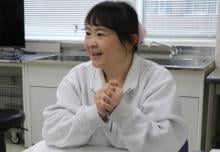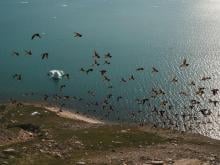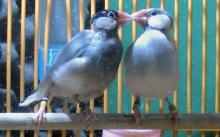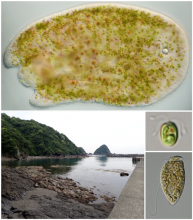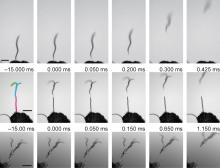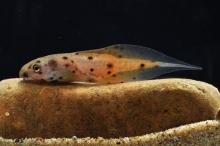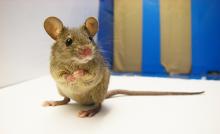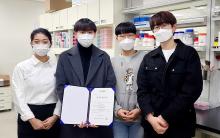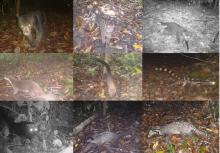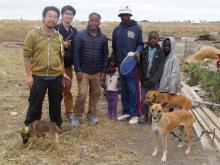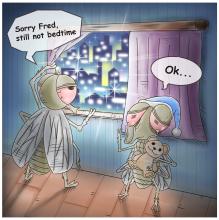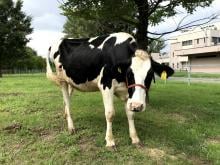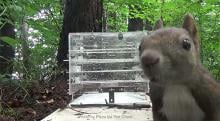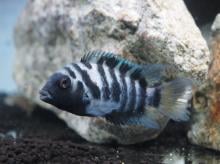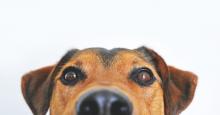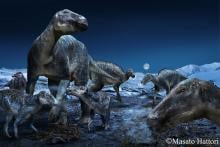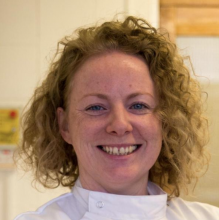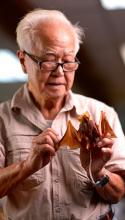Biology Zoology
News
08 Apr 2024
Genetic analysis finds evidence suggesting that acoustic fat bodies in the heads of toothed whales were once the muscles and bone marrow of the jaw.
25 Mar 2024
A marine biologist is inching closer to conquering science’s over 120-year pursuit to farm lobsters by letting these “dragons of the sea” get real weird.
15 Mar 2024
Acoustic recordings of a colony of little auks reveal their nocturnal activities and offer valuable monitoring means for avian biology in the Arctic.
15 Jan 2024
Unleashing stem cells from dog urine, Electronic Tongue, Tapping into human motion energy, How neurons network, and A radical use for plastic bags. Plus Communicating science two decades on. Read all in the latest Editor's Choice.
13 Dec 2023
Scientists at Osaka Metropolitan University have developed an efficient, non-invasive, and pain-free method to generate canine-induced pluripotent stem cells (iPSCs). They identified six reprogramming genes that can boost canine iPSC generation by 120 times compared to conventional methods using fibroblasts. The iPSCs were created from urine-derived cells without the need for feeder cells, an impossible feat until now. Their findings are expected to advance regenerative medicine and genetic disease research in veterinary medicine.
25 Oct 2023
Pair-bonded Java sparrows show enlarged eye rings to signal breeding readiness.
05 Oct 2023
Acoels have been found to host a wide diversity of symbiotic, photosynthetic microalgae.
08 Sep 2023
Capturing carbon dioxide, Shells go nuclear, Worms surf electric fields, Brain repair & Creating matter from light. Plus from our blog: Monitoring research for further impact. Read all in the latest Editor's Choice.
10 Aug 2023
Hokkaido University researchers found that tiny nematode worm larvae surf electric fields to hitch rides on passing insects.
19 Jun 2023
A key protein for sperm maturation identified, Understanding gel formation, Urine test predicts organ diseases, A laser drills holes in a graphene film. Plus in our blog - The frogs of Borneo: more than just a race. Read all in the latest Editor's Choice.
20 Mar 2023
Parasitic infections in salmonid fish can increase or decrease their vulnerability to angling, depending on their body condition.
01 Sep 2022
Lim Boo Liat (21 August 1926 – 11 July 2020), a leading authority in the conservation of Malaysia’s biological diversity, had his initial interest in the outdoors piqued by nature lessons in school.
11 Jul 2022
Important, yet often neglected: Tadpoles play a critical role in the ecology of aquatic habitats. On 279 pages, a new book presents descriptions for 99 species from the southeast Asian island of Borneo, covering all species commonly found, as well as representatives of the more cryptic ones. LIB-scientist Alexander Haas and his team of international collaborators worked over 20 years on its completion and just released “A Guide to the Tadpoles of Borneo”.
07 Jul 2022
Biologists from Hong Kong Baptist University (HKBU) have discovered in Hong Kong waters three new species of hard coral which have never been identified anywhere else in the world. The findings come shortly after their discovery of one new coral and two new nudibranch species, which was announced last year under their research project on coral health in Hong Kong.
16 Jun 2022
Scientists have revealed the genetic structure and diversity, and inferred the population history, of the wild house mouse across Europe and Asia.
11 Mar 2022
A study on puddle frogs suggests underestimated biodiversity in Southeast Asia.

17 Feb 2022
An international team of researchers respond to criticisms on previous work that demonstrated Mirror Self-Recognition (MSR) in the cleaner fish Labroides dimidiatus, by 1) successfully repeating the mark test with a larger sample size, 2) showing the MSR behaviour to be the visual result of the mark not a physical response to it, and 3) showing that MSR-trained fish do not show aggression to spatially varied mirror images of themselves. Additionally, they further demonstrate potential self-awareness in L. dimidiatus by showing that they do not demonstrate MSR behaviour when visually presented with the mark on other fish and solidify the importance of ecologically relevant marks presented in previous work by showing MSR behaviour of L. dimidiatus with brown marks, meant to resemble a main food source of the fish, as opposed to no such behaviour in fish with green or blue marks.
09 Nov 2021
Researchers from DGIST explore the role of symbiotic skin bacteria in wound healing for different fish species
20 Oct 2021
Just as humans may leave their home five minutes early to avoid a talkative neighbor or depart work late to avoid a rude coworker, carnivorous mammals may go out of their way to avoid other species. But they’re not trying to navigate awkward social interactions; rather, they are negotiating space and resources for survival.
20 Sep 2021
Võ Quý (31 December 1929 – 10 January 2017) was a Vietnamese ornithologist who studied the destruction of tropical forests and agricultural lands in Vietnam by Agent Orange, a herbicide used by the U.S. military during the Vietnam War.
13 Sep 2021
Abnormally high levels of DNA methylation have been identified in dogs exposed to high levels of lead near a mining area in Kabwe, Zambia, by a team of scientists from Japan and Zambia.
18 Aug 2021
A collaboration between Osaka City University and Setsunan University sheds light on the effect urbanization has on the flesh fly species Sarcophaga similis. Through a series of laboratory and in-field experiments, scientists show that an increase in nighttime illumination and temperature, two of the major characteristics of urbanization, can postpone S. similis hibernation anywhere from 3 weeks to a month.
31 May 2021
Scientists have shown that the population of the Yakushima sika deer has declined due to natural factors, suggesting that the population can be regulated without culling.
02 Apr 2021
Scientists in Japan have developed and tested a novel probiotic formulation to control severe diarrhea in calves, ensuring their health and reducing mortality, and in turn reducing economic loss.
30 Mar 2021
Human disturbance in urban environments makes some squirrels fail, but others perform better in novel problem-solving.
19 Mar 2021
Through a series of prosocial choice tasks, researchers reveal prosocial and antisocial characteristics in male convict cichlid fish. The fish distinguish between female breeding partners, unknown females, and rival males by adjusting their actions to either provide food for both them and the females or avoid providing food for the rival males.
21 Jan 2021
A team of scientists in Japan has developed a novel method to induce stem cell generation from the blood samples of dogs. Through this technique, the scientists hope to advance regenerative therapies in veterinary medicine. This would mean that, in the near future, veterinarians might be able to reverse conditions in dogs that were previously thought incurable.

29 Sep 2020
Climate warming will alter marine community compositions as species are expected to shift poleward, significantly impacting the Arctic marine ecosystem.
27 May 2020
A re-analysis of dinosaur skulls from northern Alaska suggests they belong to a genus that lived over a broad latitudinal range extending into the Arctic.
Events
Sorry, nothing coming up for this discipline
Researchers
Dr. Yukio Yasui is an Associate Professor at Kagawa University. He has dedicated his research work to ecology, ethology and evolutionary biology studies, with his more recent work on the evolution of sex.
Dr. Crumlish has researched aquatic microbial diseases, specifically ones that have economic impact in global aquaculture, and potential solutions to such infectious diseases. Her current project seeks to develop vaccines against antimicrobial resistance in aquaculture.
Guangshun Jiang does research in ecology and zoology with a special focus on big feline ecology and conservation research.
Giants in history
During her short life, Fahire Battalgil (1902 - 1948) achieved renown as the first zoologist from Turkey to make strides in the field of freshwater fish biodiversity.
Lim Boo Liat (21 August 1926 – 11 July 2020), a leading authority in the conservation of Malaysia’s biological diversity, had his initial interest in the outdoors piqued by nature lessons in school. Lim, who helped found the National Zoo of Malaysia and re-establish the Malaysian Nature Society, had a particular interest in researching zoonotic diseases associated with small animals.
Thai physician and conservationist Boonsong Lekagul (1907 – 1992) made major contributions to the preservation of his country’s wildlife.
Little is known about Ali, a teenager from Sarawak, Malaysia, who was chief assistant to the famous naturalist Alfred Wallace. Most of what is known comes from Wallace’s writings. Ali accompanied Wallace on expeditions throughout the Malay Archipelago from December 1855 to February 1862.
Joo-myung Seok (November 13, 1908 – October 6, 1950) was a Korean butterfly entomologist who made important contributions to the taxonomy of the native butterfly species in Korea.
Võ Quý (1929 – 2017) was a Vietnamese ornithologist who studied the destruction of tropical forests and agricultural lands in Vietnam by Agent Orange, a herbicide used by the U.S. military during the Vietnam War. In addition to planning forest restoration projects, Quý rediscovered the rare eastern sarus crane, an endangered species that had vanished during the war.




